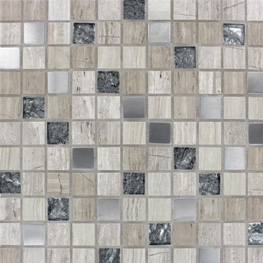
Mosaics — flat, colored tiles of glass, stone or ceramic arranged to create intricate scenes of people, places, animals, and designs — are one of the oldest forms of art in the world. Although mosaics can be found in many countries and were developed in many different ancient civilizations, mosaics were most prominent in the Hellenistic world (ancient Greece and Rome), the Byzantine world (modern day north Africa), as well as many Middle Eastern countries.
The first mosaics were made by embedding pebbles into terra cotta. This created patterns with an interesting rounded texture, but colors were limited. By 200 B.C., special, cube-shaped tiles called tesserae were created specifically to make mosaics. The first tesserae were made out of stone, brick, and terra cotta, which were sturdy materials especially well suited to create mosaic floors. Later, tesserae were made out of glass for wall and ceiling mosaics. These glass tiles were able to catch and reflect the natural light, giving the piece a brilliant shine. Tesserae were also made in many different sizes, allowing artists to create incredibly intricate masterpieces that closely resembled paintings.
The earliest Western mosaics depicted pagan imagery in the form of nature, animals, gods, and people. As civilizations developed, mosaics reflected the west’s changing religious beliefs. Stories of Greek and Roman gods, as well as the muses, were common topics and, as Christianity developed, biblical scenes were the primary focus. Although mosaics were used in private villas and public walls, they were also very common on the walls and floors of churches and mausoleums.
Byzantine and Islamic Mosaic Traditions
Byzantine mosaics borrowed from both Eastern and Western artistic traditions. Constantinople (now present-day Turkey) was famous for its gorgeous, Christian-focused mosaics that were gilded with real gold and silver leaf, which caught the light and shone — certainly inspiring religious awe! The tiles used were slightly different from the tesserae in Rome and Greece. Byzantine mosaics used tiles called smalti, which were ungrouted and made of rough glass, further enhancing the glittery effect when they caught the light.
Byzantine mosaics also featured more abstract, geometrical patterns, due to the culture’s Middle Eastern influences, which itself had a rich history of this art form. However, you won’t find any religious imagery here — in Islam it is seen as disrespectful to depict the human form of religious figures in art. Instead, mosaics focused on abstract, geometrical shapes developed from the incredibly advanced mathematics Middle Eastern societies developed and understood. However, that doesn’t mean that there was no religious expression in this art. In fact, artistic expression was seen as a way of bringing oneself closer to god and reflecting his beauty and divinity.
Like in the west, Middle Eastern mosaics covered the walls of both secular and religious buildings. Tiles were shaped into polygons, each containing girih, or lines, which formed intricate geometric patterns when joined with other tiles. For the most part, countries across the Islamic world used the same basic shapes in their tiles and, most astoundingly, was the accuracy with which they were cut and placed — the girih mosaics had to be perfectly shaped or the polygonal patterns would not fit together properly. The shapes and patterns that resulted are called quasicrystalline patterns, which never repeat but are always perfectly symmetrical. It wasn’t until the 1970s that westerners understood the math behind these patterns, but Islamic societies have known their secrets since at least the 13th century!
Mosaics in the Modern World: From Galleries to Sidewalks
Mosaics went in and out of fashion but continued to be used primarily in religious art over the centuries. In more recent times, abstract styles became popular and mosaics were incorporated into surrealist art. Today, mosaics tend to be a popular form of street and modern art and can be seen everywhere from the New York City Subway to streetlamps on the sidewalk. While angular, often square or cube-shaped tiles are still common, modern mosaics can incorporate a wide range of materials, from broken pottery to found objects. And, like in ancient times, they are still a striking way to accent your home — creating the feel of your very own palace. Whether you’d like a mosaic masterpiece in your front hall or simply want to spice up your kitchen backsplash, this is one ancient art that shouldn’t be forgotten.
